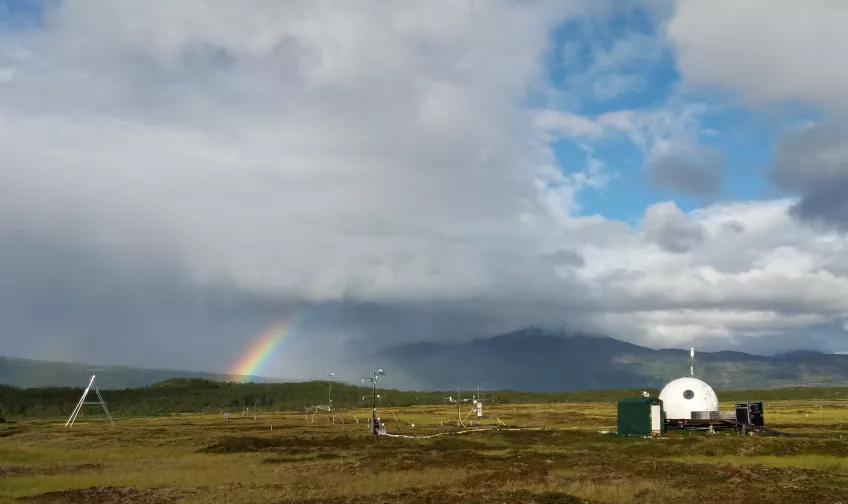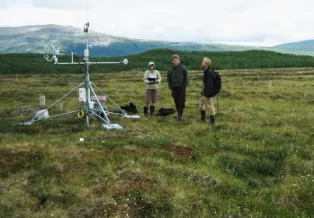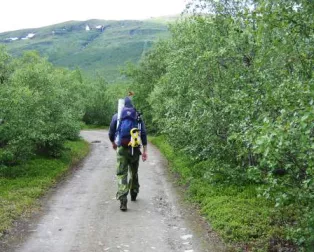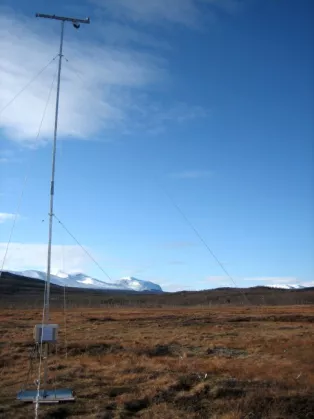Carbon estimation
The increasing global mean air temperature and other climatic changes are driven by the increase of atmospheric greenhouse gas concentrations, of which carbon dioxide (CO₂) is the most important one. The atmospheric concentration is moderated by the exchange of CO₂ between the atmosphere and the biosphere; the net exchange is a result of photosynthesis that takes up and respiration that releases CO₂. Satellite sensor-derived data are suitable for regional or global estimations of CO₂ exchange. By using vegetation indices, such as the normalized difference vegetation index (NDVI) and the enhanced vegetation index (EVI), as input data to light use efficiency (LUE) models and LUE-based empirical models, the photosynthetic uptake of CO₂ has been estimated for several ecosystems in the Nordic countries, the Sahel in Africa and in Greenland. Since LUE models describe how radiation energy is converted into biomass, the incoming photosynthetically active radiation that is absorbed by vegetation (APAR) is an essential input to these models. For some ecosystems, also respiratory release of CO₂ has been estimated by driving relationships with satellite-derived land surface temperature. When both the uptake and release of CO₂ are known, then the net exchange can be calculated. We calibrate and test models against eddy covariance tower measurements of CO₂ exchange.
Some of our main research activities are driven by questions, such as the following: 1) Is it possible to reduce the uncertainties in our estimates of vegetation productivity and ecosystem respiration by combining in situ, EO and dynamic vegetation modelling methods? 2) How do vegetation productivity and C cycling respond to changes in environmental conditions at different spatial and temporal scales? 3) Finally, how can different types of EO products be used for improving our understanding of the role of different biomes across the world on the global C cycle? By responding to these research questions, we hope to increase our understanding of the possible feedback mechanisms that vegetation responses might impose on the global C cycle as well as on current and future climatic change. This is particularly important for improved quantifications of national contributions within the Paris Climate Agreement, and for improved climate change mitigation and adaptation strategies.
Our current research interests include:
- Describing vegetation structure and function, such as the leaf area index (LAI) and fractional absorption of photosynthetically active radiation (fAPAR), in order to integrate these in carbon models.
- Developing methods for handling time series of satellite sensor-derived data, in order to generate improved time series of these data.
- Using near-ground sensors for spectral measurements for calibration of satellite sensor-derived data and better understanding of ecosystem processes.
- Monitoring changes in vegetation cover in different climate regions and ecosystems.
Read more about dryland ecosystems.
We have published a number of articles related to carbon estimation, of which some are given here:
References
- Eklundh, L., Hall, K., Eriksson, H., Ardö, J. and Pilesjö, P., 2003, Investigating the use of LANDSAT Thematic Mapper data for estimation of forest leaf area index in southern Sweden. Canadian Journal of Remote Sensing, 29, 349-362.
- Eklundh, L., Harrie, L. and Kuusk, A., 2001, Investigating relationships between Landsat ETM+ sensor data and leaf area index in a boreal conifer forest. Remote Sensing of Environment, 78, 239-249.
- Eriksson, H., Eklundh, L., Hall,K. and Lindroth, A., 2005, Estimating leaf area index in deciduous forest stands. Agricultural and Forest Meteorology, 129, 27-37.
- Dubber, W., Eklundh, L., Lagergren, F., 2017, Comparing field inventory with mechanistic modelling and light-use efficiency modelling based approaches for estimating forest net primary productivity at a regional level. Boreal Environment Research, 22, 337-352.
- Olofsson, P. and Eklundh, L., 2007, Estimation of absorbed PAR across Scandinavia from satellite measurements. Part II: modeling and evaluating the fractional absorption. Remote Sensing of Environment, 110, 240-251. http://dx.doi.org/10.1016/j.rse.2007.02.020
- Olofsson, P., Eklundh, L.,Lagergren, F., Jönsson, P. and Lindroth, A., 2007, Estimating Net Primary Production for Scandinavian forests using data from Terra/MODIS. Advances in Space Research, 39, 125-130. http://dx.doi.org/10.1016/j.asr.2006.02.031
- Olsson, P.O., Heliasz, M., Jin, H.X., Eklundh, L., 2017, Mapping the reduction in gross primary productivity in subarctic birch forests due to insect outbreaks. Biogeosciences, 14, 1703-1719.
- Olofsson, P., Lagergren, F.,Lindroth, A., Lindström, J., Klemedtsson, L., Kutsch, W. and Eklundh, L., 2008, Towards Operational Remote Sensing of Forest Carbon Balance across Northern Europe. Biogeosciences, 5, 817-832. http://www.biogeosciences.net/5/817/2008/bg-5-817-2008.html
- Olofsson, P., Van Laake, P. E. and Eklundh, L., 2007, Estimation of absorbed PAR across Scandinavia from satellite measurements. Part I: Incident PAR. Remote Sensing of Environment, 110, 252-261. http://dx.doi.org/10.1016/j.rse.2007.02.021
- Schubert P., Lagergren F., Aurela M., Christensen T., Grelle A., Heliasz M., Klemedtsson L., Lindroth A., Pilegaard K., Vesala T., Eklundh L., 2012, Modeling GPP in the Nordic forest landscape with MODIS time series data - comparison with the MODIS GPP product, Remote Sensing of Environment, 126, 136-147. http://dx.doi.org/10.1016/j.rse.2012.08.00
- Sjöström, M., Ardö, J., Arneth, A., Cappelaere, B., Eklundh, L., de Grandcourt, A., Kutsch, W. L., Merbold, L., Nouvellon, Y., Scholes, B., Seaquist, J. and Veenendaal, E. M., 2011, Exploring the potential of MODIS EVI for modeling gross primary production across African ecosystems. Remote Sensing of Environment, 115, 1081-1089. http://dx.doi.org/10.1016/j.rse.2010.12.013
- Tagesson T., Mastepanov M., Tamstorf M.P., Eklundh L., Schubert P., Ekberg A., Sigsgaard C., Christensen T.R., Ström L., 2012, High-resolution satellite data reveal an increase in peak growing season gross primary production in a high-Arctic wet tundra ecosystem 1992-2008, International Journal of Applied Earth Observations and Geoinformation, 18, 407-416. http://dx.doi.org/10.1016/j.jag.2012.03.016
- Schubert, P., Lund, M., Ström, L., and Eklundh, L., 2010, Impact of nutrients on peatland GPP estimations using MODIS time series data, Remote Sensing of Environment, 114, 2137-2145. http://dx.doi.org/10.1016/j.rse.2010.04.018
- Schubert, P., Eklundh, L., Lund, M. and Nilsson, M., 2010, Estimating northern peatland CO2 exchange from MODIS time series data, Remote Sensing of Environment, 114, 1178-1189. http://dx.doi.org/10.1016/j.rse.2010.01.005
- Sjöström M., Ardö J., Eklundh L., El-Tahir B.A., El-Khidir H.A.M., Pilesjö P. and Seaquist J., 2009, Evaluation of satellite based indices for primary production estimates in a sparse savanna in the Sudan. Biogeosciences, 6, 129-138. http://www.biogeosciences.net/6/129/2009/bg-6-129-2009.html
- Seaquist, J. W., Olsson, L., Ardö, J. and Eklundh, L., 2006, Broad-scale increase in NPP Quantified for the African Sahel, 1982-1999. International Journal of Remote Sensing, 27, 5115-5122.
Contact information
Lars Eklundh
lars [dot] eklundh [at] nateko [dot] lu [dot] se
Phone: +46462229655





